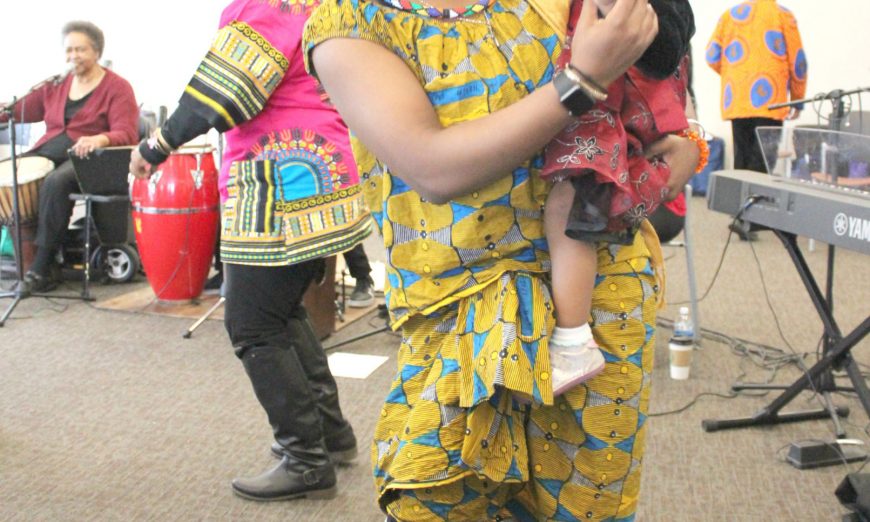At the start of Mission College’s Dec. 6 Kwanzaa Celebration, student Dorothy Stone explained that Kwanzaa, from the Swahili phrase “first fruits,” is a ceremony that celebrates family, community and culture from Dec. 26 to Jan. 1. Student Diana Silveira added that Kwanzaa is celebrated through feasting, rituals, dialogue, narratives, poetry, dancing, drumming and other music. Other students elaborated on Kwanzaa’s guiding principles, translated from Swahili to English: umoja (unity), kujichagulia (self-determination), ujima (collective work and responsibility), ujamaa (cooperative economics), nia (purpose), kuumba (creativity) and imani (faith). The presenting students are in Humanities 18, a class taught by Dr. David Piper, adjunct faculty in the Liberal Studies, Liberal Arts and Counseling departments.
The buffet lunch included barbecued chicken and collard greens. Drummers from the Claude Ferguson Art Ensemble performed. Also providing musical entertainment was the Oakland-based Cultural Heritage Choir, nominated for a Grammy in 1997 in the Children’s Music category for the album “Shakin’ a Tailfeather,” done in collaboration with Taj Mahal and Eric Bibb. At Mission College, the Cultural Heritage Choir’s showcase of traditional African American roots music demonstrated the genre’s harmony and vivacity. With the accompaniment of percussion instruments, the program began with the soul-stirring rhythmic spirituals “God’s Gonna Set This World on Fire” and “Train Medley.”
“The life span of traditional music is endless,” said Linda Tillery, artistic director of the Cultural Heritage Choir. “The life span of popular music lasts as long as people have money to buy that music. Who doesn’t know this song?”
Then Tillery and her band broke into the smooth and melodious “Swing Low, Sweet Chariot,” a timeless African American spiritual song. Other band members included Bryan Dyer, Tammi Brown, Zoe Ellis and Javier Navarrette.
[wp-anything-slider setting=’SETTING2′]
After the program, Tillery said that around 1992, she saw a TV program on PBS called “Spirituals in Concert.”
“That concert awakened in me a real deep hunger for music that I used to hear my grandfather sing,” Tillery said. “One song led to another. I was thinking, ‘I remember that song. I remember that song.’ So I thought I could broaden my scope by doing some serious research about African roots music and that’s what I did. I went to the Smithsonian and the Library of Congress and I found music going back to the early 20th century.”
Tillery also credited three scholars of music for their guidance—Dr. Portia Maultsby, Dr. Horace Boyer, and Jacqueline Hairston.
“I have a personal library of music about slave culture and the development of music in the Black church,” Tillery said. “These long-metered hymns are one of the oldest song forms in Black sacred music. The way they developed it was through the practice of call and response. During the 1700s, in response to a couple of major slave uprisings, some of the clergy in the southeastern regions sent some Christian hymns to the southeastern United States because they felt that those particular hymns would have a calming effect on the enslaved Africans. They felt that African root music incited the slave population to revolt. Since the majority of enslaved Africans couldn’t read, they would do call and response.”
Visit www.facebook.com/culturalheritagechoir/ for more information about Tillery and the Cultural Heritage Choir.






